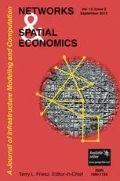Abstract
This paper develops a combined mode choice and traffic assignment model that incorporates ridesharing as an option in a mode choice model, attempting to quantify the ridesharing market share in an equilibrium context. The mode choice model takes into account that the waiting time for a ride is dependent on the available drivers. The traffic assignment model is a static user equilibrium that interacts with the discrete choice model through level of service variables. An iterative algorithm was implemented and applied in a simple network and a more realistic network. The results indicate that the quantity of ride sharing drivers is a key parameter to the service success, and below a critical mass of drivers, it is unlikely that passengers will find the service valuable. It is also shown that ride sharing has the ability to reduce in-vehicle times for all the users, although passenger may suffer from longer door-to-door times, having to wait for their ride.








Similar content being viewed by others
References
Agatz N, Erera A, Savelsbergh M, Wang X (2010) Sustainable passenger transportation: dynamic ride-sharing. Tech. rep., Rotterdam School of Management, Erasmus University
Agatz NA, Erera AL, Savelsbergh MW, Wang X (2011) Dynamic ride-sharing: a simulation study in metro Atlanta. Transp Res B Methodol 45(9):1450–1464
Amey AM (2010) Real-time ridesharing: exploring the opportunities and challenges of designing a technology-based rideshare trial for the MIT community (Doctoral dissertation, Massachusetts Institute of Technology)
Bajwa S, Bekhor S, Kuwahara M, Chung E (2008) Discrete choice modeling of combined mode and departure time. Transportmetrica 4(2):155–177
Bekhor S, Toledo T, Prashker JN (2008) Effects of choice set size and route choice models on path-based traffic assignment. Transportmetrica 4(2):117–133
Bureau of Transportation Statistics (2010) Transportation Statistics Annual Report 2010. U.S. Department of Transportation, Research and Innovative Technology Administration
Cepeda M, Cominetti R, Florian M (2006) A frequency-based assignment model for congested transit networks with strict capacity constraints: characterization and computation of equilibria. Transp Res B Methodol 40(6):437–459
Chan ND, Shaheen SA (2012) Ridesharing in North America: past, present, and future. Transp Rev 32(1):93–112
Dafermos S (1980) Traffic equilibrium and variational inequalities. Transp Sci 14(1):42–54
Deakin E, Frick KT, Shively KM (2010) Markets for dynamic ridesharing? Transp Res Rec: J Transp Res Board 2187(1):131–137
Dueker KJ, Bair BO, Levin IP (1977) Ride-sharing: psychological factors. J Transp Eng 103(6):685–692
Ferguson E (1997) The rise and fall of the american carpool: 1970–1990. Transportation 24(4):349–376
Florian M (1977) A traffic equilibrium model of travel by car and public transit modes. Transp Sci 11(2):166–179
Ghoseiri K, Haghani AE, Hamedi M (2011) Real-time rideshare matching problem. Mid-Atlantic Universities Transportation Center
Habib KMN, Tian Y, Zaman H (2011) Modelling commuting mode choice with explicit consideration of carpool in the choice set formation. Transportation 38(4):587–604
Hall RW, Qureshi A (1997) Dynamic ride-sharing: theory and practice. J Transp Eng 123(4):308–315
Horowitz AD, Sheth JN (1977) Ride sharing to work: an attitudinal analysis. Transp Res Rec 637:1–8
Huang HJ, Yang H, Bell MG (2000) The models and economics of carpools. Ann Reg Sci 34(1):55–68
Kleiner A, Nebel B, Ziparo VA (2011) A mechanism for dynamic ride sharing based on parallel auctions. In: Proceedings of the Twenty-Second International Joint Conference on Artificial Intelligence (IJCAI), vol 11, p 266–272
Levofsky A, Greenberg A (2001) Organized dynamic ride sharing: the potential environmental benefits and the opportunity for advancing the concept. In: Transportation Research Board 2001 Annual Meeting
Li D, Miwa T, Morikawa T (2014) Considering en-route choices in utility-based route choice modelling. Netw Spat Econ 14:581–604
Magnanti TL, Perakis G (2004) Solving variational inequality and fixed point problems by line searches and potential optimization. Math Program 101(3):435–461
Nguyen S, Pallottino S (1988) Equilibrium traffic assignment for large scale transit networks. Eur J Oper Res 37(2):176–186
Patriksson M (2004) Algorithms for computing traffic equilibria. Netw Spat Econ 4:23–38
Peeta S, Ziliaskopoulos AK (2001) Foundations of dynamic traffic assignment: the past, the present and the future. Netw Spat Econ 1:233–265
Pisarski A (2006) Commuting in America III: the third national report on commuting patterns and trends (No. 550). Transportation Research Board
Schrank DL, Lomax TJ (2007) The 2007 urban mobility report. Texas Transportation Institute, Texas A & M University
Sheffi Y (1985) Urban transportation networks: equilibrium analysis with mathematical programming methods. Prentice-Hall, Englewood Cliffs
Tsao HSJ, Lin DJ (1999) Spatial and temporal factors in estimating the potential of ride-sharing for demand reduction. California Partners for Advanced Transit and Highways (PATH)
Wu JH, Florian M, Marcotte P (1994) Transit equilibrium assignment: a model and solution algorithms. Transp Sci 28(3):193–203
Yang H, Bell MG (1997) Traffic restraint, road pricing and network equilibrium. Transp Res B Methodol 31(4):303–314
Yang H, Lau YW, Wong SC, Lo HK (2000) A macroscopic taxi model for passenger demand, taxi utilization and level of services. Transportation 27(3):317–340
Author information
Authors and Affiliations
Corresponding author
Rights and permissions
About this article
Cite this article
Bahat, O., Bekhor, S. Incorporating Ridesharing in the Static Traffic Assignment Model. Netw Spat Econ 16, 1125–1149 (2016). https://doi.org/10.1007/s11067-015-9313-7
Published:
Issue Date:
DOI: https://doi.org/10.1007/s11067-015-9313-7




